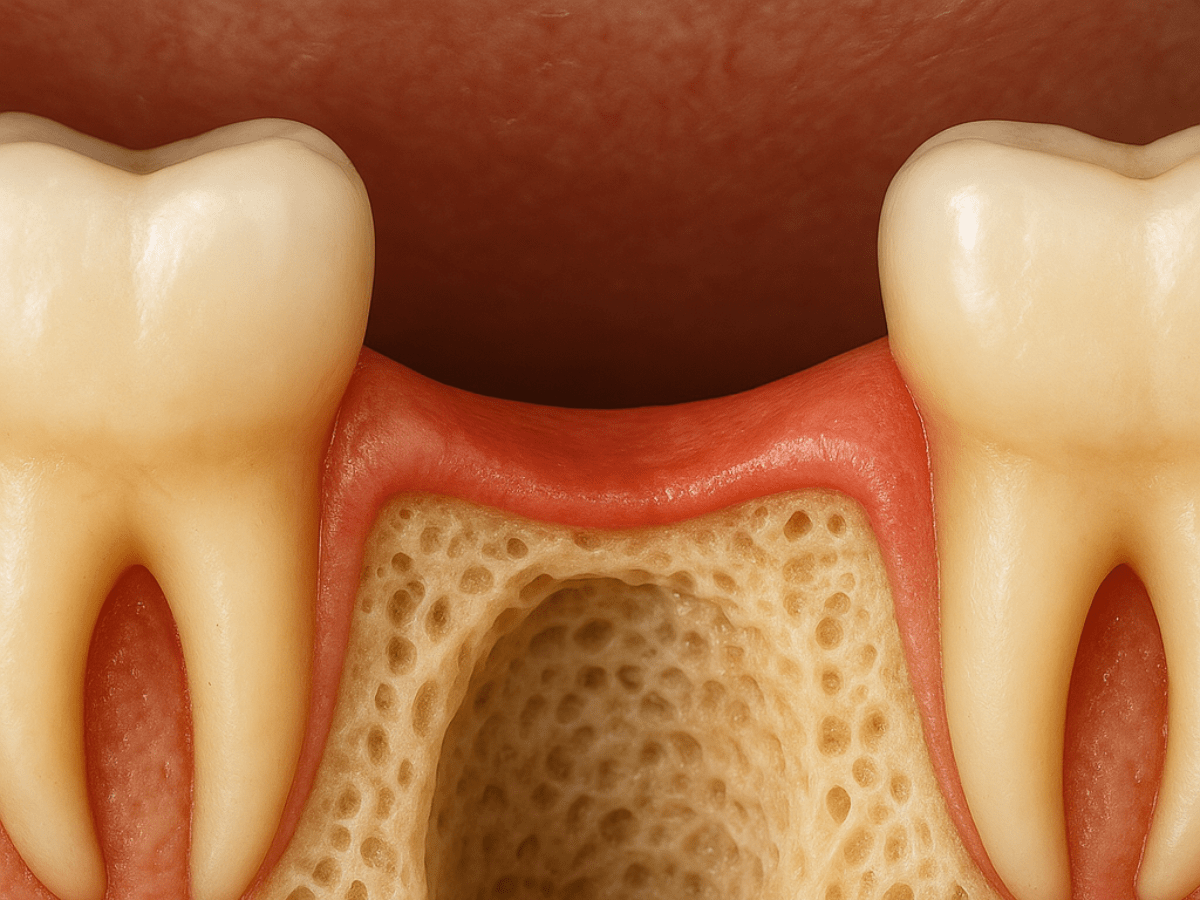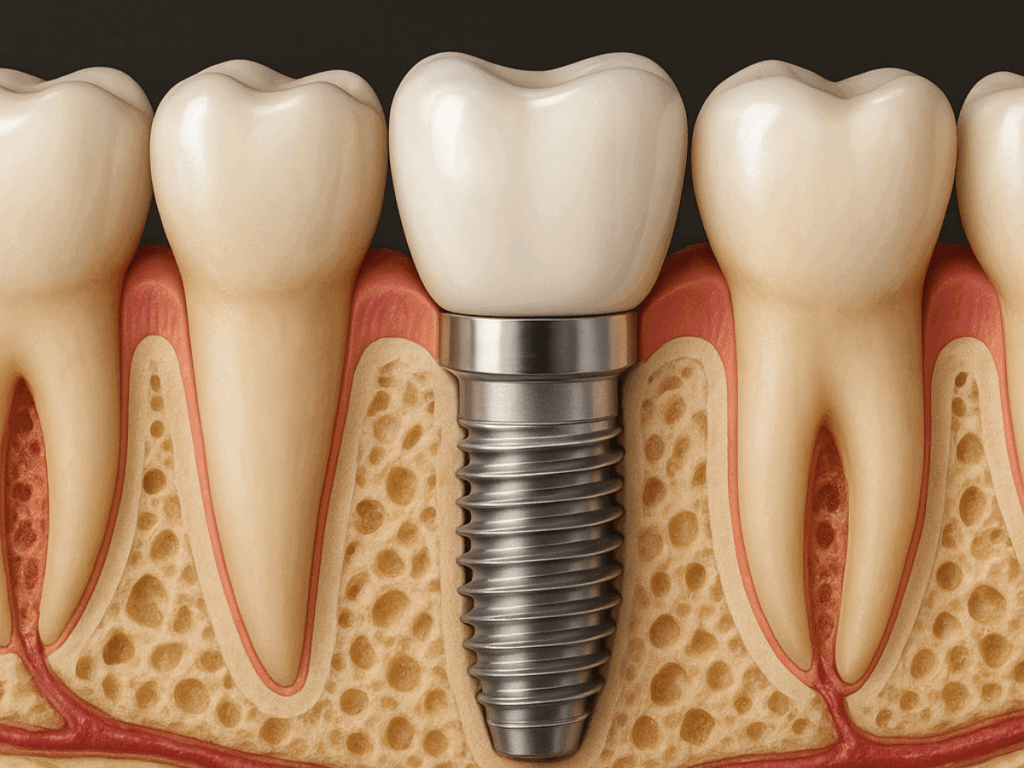A dental implant is designed to feel, function, and look like a natural tooth. Implants have a success rate of over 95%, making them one of the most reliable tooth-replacement options available. Still, even with advanced materials and skilled placement, problems can arise.
At Elizabeth L. Wakim DDS, we use state-of-the-art planning tools, including 3D imaging and precise guided placement, to reduce risks and ensure that each implant integrates smoothly with your bone and gums. Our team focuses on early detection and ongoing care so that every patient receives the safest treatment possible and long-lasting results.
Understanding potential dental implant complications can help you spot warning signs early and protect your investment in your smile. In this guide, we break down the most common implant problems, explain why they occur, share early red flags to watch for, and offer tips on lowering your risk before and after treatment.
What You Should Know About Dental Implants Before Getting One
A dental implant is a small, screw-shaped post made of medical-grade titanium or ceramic. It is surgically placed into the jawbone where it serves as an artificial tooth root. Once the implant fuses with the bone in a process called osseointegration, it provides a strong, stable foundation for a crown, bridge, or denture.
Dentists recommend implants to:
- Replace a single missing tooth without altering nearby healthy teeth
- Support bridges when several teeth in a row are missing
- Stabilize loose or removable dentures for better chewing and speaking function
- Preserve the jawbone and facial structure that often shrink when teeth are missing
Because implants look, feel, and function like natural teeth, they have become one of the most trusted solutions for restoring both oral health and confidence in your smile.
How Safe Are Dental Implants Really?
Dental implants are built to last, but their success depends on more than just the implant itself. Modern techniques like 3D imaging, guided placement, and high-quality materials have made the procedure safer and more predictable than ever before.
However, individual factors such as the density of your jawbone, your healing response, and existing issues like gum disease or smoking can influence recovery and long-term stability. Post-surgical care is equally important: following instructions on hygiene, diet, and checkups reduces the risk of infection or early failure.
Understanding these factors helps patients see why implants are typically safe yet still require thoughtful planning and consistent care to achieve the best outcome. Our guide on what you should know about dental implants offers more insights on how to prepare for treatment and maintain long-term success.
Common Dental Implant Issues You Shouldn’t Overlook
While dental implants are highly successful, issues can still arise during healing or years after placement. Knowing these potential complications helps you catch problems early and protect your investment in your smile.
1. Infection at the Implant Site
Infections can develop soon after surgery or later if bacteria enter the surrounding tissue. Warning signs include swelling, redness, tenderness, or a persistent bad taste near the implant. Early treatment with cleaning and antibiotics often prevents further damage.
2. Peri-implantitis and Mucositis (Gum Inflammation and Bone Loss)
These conditions start as gum irritation (mucositis) but can progress to peri-implantitis, which damages the bone that supports the implant. Red or bleeding gums, tenderness, or mild swelling around the implant are early red flags.
3. Implant Failure or Lack of Osseointegration
For an implant to succeed, it must bond securely with the jawbone in a process called osseointegration. If this fails, the implant may feel loose or painful. Causes can include insufficient bone density, infection, or too much stress on the implant during healing.
4. Sinus Complications and Perforation
Implants placed in the upper jaw can sometimes extend into the nearby sinus cavity. This may cause sinus irritation, facial pain, or chronic congestion. Proper pre-surgical imaging and experienced placement greatly reduce this risk.
5. Nerve Damage and Sensory Issues
If an implant is placed too close to a nerve in the lower jaw, it can lead to numbness, tingling, or sharp or throbbing pain in the lips, chin, or gums. These symptoms should be evaluated by your dentist right away to avoid lasting complications.
6. Fracture or Mechanical Failures
Stress from chewing, teeth grinding, or certain lifestyle factors can loosen the crown or abutment or, in rare cases, crack the metal post itself. Routine checkups help detect early wear before it causes the dental implant to fail or damages the surrounding bone.
7. Gum Recession and Aesthetic Changes
Over time, some patients notice the gum tissue around an implant receding, which can expose the metal under the crown. Poor oral hygiene, gum inflammation, or improper implant placement can contribute to this problem. Early treatment and consistent care reduce the chance of these changes.
8. Adjacent Tooth Damage or Tissue Injury
During dental implant placement, the dental professional places the implant carefully to avoid harming nearby teeth, but in rare cases the procedure can irritate a damaged tooth or soft tissue. Advanced imaging and guided techniques help lower the risk of injury and prevent sinus problems or sinus infections in the upper jaw.
Early vs. Late Complications
Not all implant problems happen right after surgery. Some appear in the first few weeks, while others may take years to develop. Knowing the difference helps you understand what is normal during healing and what may need attention.
- Early Complications: These usually occur within the first few weeks or months after placement. They include infection at the implant site, delayed healing, or the implant failing to fuse properly with the bone.
- Late Complications: These tend to appear after the implant has been in place for a while. They can include gum inflammation leading to bone loss (peri-implantitis), mechanical wear such as a loose crown or broken screw, or changes in bite caused by gradual bone loss.
Recognizing whether an issue is early or late can help your dentist decide on the right treatment plan and prevent further damage to the implant or surrounding tissues. Regular follow-ups, such as the 10-year implant maintenance checkup, also play a key role in catching small problems before they turn into major complications.
Who Is More at Risk for Dental Implant Complications
While most patients recover well after dental implant surgery, certain factors can increase the risk of complications during healing or years later. Knowing your personal risk factors allows you and your dentist to take steps that support a smoother healing process and better long-term results.
Gum Disease or Poor Oral Health

More than 42 percent of adults over 30 have gum disease, and about 8 percent have severe periodontal disease, which makes healthy gums essential for implant success. Untreated gum problems can slow bone growth around the implant post and increase the risk of dental implant failure.
Smoking and Tobacco Use

Patients who do not avoid smoking often experience slower healing because nicotine limits blood flow to the gums. This increases the chances of bacterial infection and can interfere with successful implant treatment.
Chronic Health Conditions

Conditions like uncontrolled diabetes, osteoporosis, or immune system disorders can affect how well the body heals after this surgical procedure. Sharing your full medical history with your dentist or oral and maxillofacial surgery specialist helps ensure the right precautions are taken.
Insufficient Bone Density or Volume

If there is not enough bone in the jaw, the implant may not fuse properly with the surrounding tissue. In such cases, bone grafting before dental implant placement can create the stable foundation needed for replacing missing teeth.
Teeth Grinding (Bruxism)

Constant pressure from clenching or grinding can lead to implant fractures or gradual loosening over time. Your dentist may recommend a night guard to reduce stress on the implant and protect nearby other teeth.
What to Do if You Notice These Symptoms
If you develop swelling, redness, looseness, or any unusual discomfort around your implant, do not wait for it to go away on its own. Acting quickly often prevents minor issues from becoming major problems.
- Call Your Dentist Immediately: Persistent pain, gum bleeding, or changes in how the implant feels should be checked as soon as possible.
- Avoid Self-Treating: Home remedies like saltwater rinses may soothe mild irritation but will not address serious complications such as infection or bone loss.
- Follow Your Dentist’s Advice: If your provider recommends antibiotics, an adjustment to the crown, or further imaging, follow the instructions carefully to protect the implant and surrounding tissues.
- Maintain Good Oral Hygiene: Continue gentle brushing and flossing around the implant unless advised otherwise.
Prompt attention helps preserve the implant, safeguards your oral health, and reduces the need for more complex treatment later. Staying on top of regular dental checkups also makes it easier for your dentist to catch early signs of implant trouble before they become serious.
Protect Your Smile and Act Early on Any Concerns
Most dental implants last for decades and feel just like natural teeth, but staying alert to potential problems is key to keeping them healthy. If you notice tenderness, swelling, changes in bite, or pain around your implant, it is always best to get it checked right away rather than wait for it to worsen.
At Elizabeth L. Wakim DDS, we use advanced planning tools, including 3D imaging and guided placement, to minimize risks and ensure long-term success for every patient. Our team is committed to early detection, prompt care, and personalized guidance to keep your smile strong for years to come.
Call our Pennsylvania office at (724) 558-8222 or use our contact form to schedule a consultation today. Whether you are considering implants or experiencing discomfort with an existing one, we are here to help you protect your oral health and feel confident about your treatment.

